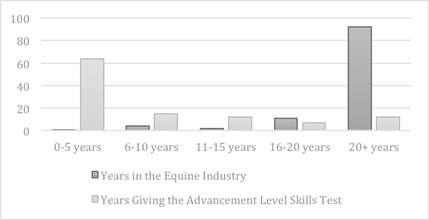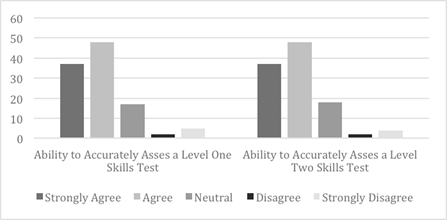 |
February 2015
|
February 2015 // Volume 53 // Number 1 // Tools of the Trade // v53-1tt5
Online Leader Training Course: Nebraska Equine Extension Leader Certification
Abstract
The Nebraska Equine Advancement Level Leader Certification Program is an online learning tool that clarifies principles of the Nebraska 4-H Equine Advancement Programs. Through an online Moodle course through eXtension.org, 4-H leaders and Extension educators are able to fulfill the certification requirement from any location before allowing youth to progress through the Equine Advancement Levels. Participants of the course must read required materials, watch informational videos, and complete short assessments prior to being awarded certification. Participant survey results of the online course verify the course's accessibility and feasibility and its ability to train equine leaders and educators at a distance.
Introduction and Objectives
The objective of the Nebraska 4-H Equine Advancement Programs (NEAP) Leader Certification Program was to create an online learning tool that clarified principles of the program to those leaders providing the testing. The NEAP consists of record sheets to monitor the progress of the 4-Her, written exams, demonstrations, and horse skills tests. Due to a variety of people evaluating the NEAP, Nebraska Equine Extension found it vital to educate testers on the principles and procedures of the four riding skill levels. As changes within the Nebraska Equine 4-H program occurred, a testing model was created so that all 4-H participants are evaluated fairly and correctly in each level of testing.
This online course was created to ensure that Equine 4-H leaders could assess the safety of 4-H members while working with their horses and their skill level to properly move them through the four levels. The program was designed as a tool for Extension to use in any area of certification, staying abreast with the ideas of Van Horn, Flanagan, and Thomson (1999), which were to make advancements within Extension that are progressive with the times and that strengthen the 4-H program, leaders and youth.
Materials and Methods
An online Moodle course was designed that was accessible for Equine 4-H leaders and Extension educators throughout the state through the Campus portal on eXtension.org. Online learning gives participants the option of completing modules during their peak learning times and to have access to more information (Kaslon, Lodl, & Greve, 2005). This provided reasoning for the decision to develop an online training for 4-H equine leaders and Extension educators. The online training program will certify equine club leaders, Extension staff, and examiners on how to appropriately score and judge the riding skills portion of the NEAP. Within the online tutorials, text descriptions, video examples, and images were available to understand the concepts to be evaluated by 4-H members.
Because all equine 4-H leaders are required to complete this certification prior to testing youth on their NEAP, it was determined that distance delivery was the best method to conduct this course. An online certification program that could be accessible from anywhere in the state of Nebraska was the most suitable solution to the demand for accessibility (Rader, 2012). The online certification program would not only lend itself to being a reference for 4-H leaders and Extension educators, but to being an assessment of their own equine knowledge. Learning quizzes were placed at the end of each module and had to be passed before proceeding throughout the certification program to ensure comprehension. The examinations include a bank of questions from the manual, modules, and videos, and are generated at random for each quiz.
As shown in a study regarding online certification programs, examinations also enable interactive learning (Robideau & Vogel, 2014). This was determined to be a vital component of establishing deeper learning, because the certification course required active participation of the participants. Surveys were completed upon the conclusion of the course to gather data of participants' course understanding and solicit suggestions.
Results and Discussion
The NEAP Leader Certification Program has currently been completed by 109 Equine 4-H leaders or Extension educators. Figure 1 shows the number of years the leaders have been involved in the equine industry and the number of years they have been giving the NEAP Skills Test. The largest demographic of those administering the Level 1 and 2 tests are horsemen with more than 20 years of experience in the equine industry and horsemen with less than 5 years giving the 4-H NEAP Skills test (n=109). Many of the leaders in the state have a great deal of horse industry experience but have not been giving the 4-H riding skills test for very long. Through the online course, the large number of experienced horse people in the state who were previously not involved can now become certified and involved in the NEAP as they can take the online course at their convenience. Once they are certified they can start administering and working with youth in their area on horse handling and riding skills.
Figure 1
4-H Equine Facilitators of Time in the Equine Industry vs. Years Proctoring Skills Test

Seventy-six percent of leaders indicated that after the online course they were more capable of assessing the abilities of youth on whether or not they should pass their Level 1 or 2 horse skills test regardless of the previous equine experience (Figure 2). This shows that the online course was successful in providing information to the leaders through a distance model.
When asked if the certification course allowed them to feel more confident, participants responded with comments similar to the following:
- "Allowed new leaders to gain confidence in their testing of riders."
- "Videos gave details so that I can teach the kids when preparing for the test and the clarifications of what actions can cause a failure on the skills test."
Figure 2.
Online Leader Training Course Assessment of 4-H Level 1 and 2 Equine Skill Tests

Participants were asked to suggest improvements for the online course. The responses below summarize their thoughts:
- "Videos would be good to show to 4-H youth as well as instructors."
- "No suggestions, videos were educational and easy to follow along—would be good for new riders."
Overall, 71% of the 109 participants rated the online course a score of 8 or above, with 10 being the highest rating. An online certification program is a readily accessible option for training equine 4-H leaders. By being offered the certification entirely online, level testers gain access to the information at any given time. Additionally, an online training course is a more feasible option for Nebraska Equine Extension, rather than providing in-person training, considering the associated expenses and travel costs.
Conclusion
The NEAP Leader Certification Program multiplies training efforts by creating a more assessable course for horse leaders. The program can be used as a reference for the leaders as they continue to educate youth on the correct equine practices. The feasibility of an online certification program promotes its use throughout Extension, specifically because of its accessibility and adaptability to any program.
References
Kaslon, L., Lodl, K., & Greve, V. (2005). Online leader training for 4-H volunteers: A Case study of action research. Journal of Extension [On-line], 43(2). Article 2FEA4. Available at: http://www.joe.org/joe/2005april/a4.php
Rader, H. (2012). Going the distance part 1: Three keys to successful delivering an Extension course at a distance. Journal of Extension [On-line], 50(6). Article 6TOT4. Available at: http://www.joe.org/joe/2012december/tt4.php
Robideau, K., & Vogel, E. (2014). Development strategies for online volunteer training modules: A Team approach. Journal of Extension [On-line], 52(1). Article 1FEA6. Available at: http://www.joe.org/joe/2014february/a6.php
Van Horn, B., Flanagan, C., & Thomson, J. (1999). Changes and challenges in 4-H (part 2). Journal of Extension [On-line], 37(1). Article 1COM1. Available at: http://www.joe.org/joe/1999february/comm1.php




